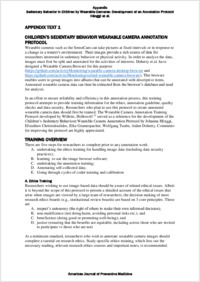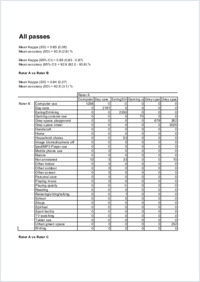Sedentary behavior in children by wearable cameras: development of an annotation protocol
- Hänggi, Johanna M. School of Education, University of Applied Sciences Northwestern Switzerland, Brugg, Switzerland - Movement and Sports Science, Department of Neurosciences and Movement Sciences, University of Fribourg, Fribourg, Switzerland
- Spinnler, Simon Department of Sport, Exercise and Health, University of Basel, Basel, Switzerland
- Christodoulides, Efstathios Sport and Exercise Science, School of Science, University of Central Lancashire (UCLan) Cyprus, Larnaca, Cyprus
- Gramespacher, Elke School of Education, University of Applied Sciences Northwestern Switzerland, Brugg, Switzerland
- Taube, Wolfgang Movement and Sports Science, Department of Neurosciences and Movement Sciences, University of Fribourg, Fribourg, Switzerland
- Doherty, Aiden Big Data Institute, Li Ka Shing Centre for Health Information and Discovery, University of Oxford, Oxford, United Kingdom - National Institute of Health Research Oxford Biomedical Research Centre, Oxford University Hospitals NHS Foundation Trust, John Radcliffe Hospital, Oxford, United Kingdom
-
01.12.2020
Published in:
- American Journal of Preventive Medicine. - 2020, vol. 59, no. 6, p. 880–886
English
Introduction: There is increasing evidence that not all types of sedentary behavior have the same harmful effects on children's health. Hence, there has been a growing interest in the use of wearable cameras. The aim of this study is to develop a protocol to categorize children's wearable camera data into sedentary behavior components.Methods: Wearable camera data were collected in 3 different samples of children in 2014. A development sample (3 children aged 4–8 years) was used to design the annotation protocol. A training sample (4 children aged 10 years) was used to train 3 different coders. The independent reliability sample (14 children aged 9–11 years) was used for independent coding of wearable camera images and to estimate inter-rater agreement. Data were analyzed in 2018. Cohen's κ was calculated for every rater pair on a per-participant basis. Means and SDs were then calculated across per-participant κ scores.Results: A total of 41,651 images from 14 participants were considered for analysis. Inter-rater agreement over all raters over all the sedentary behavior components was almost perfect (mean κ=0.85, 95% CI=0.83, 0.87). Inter-rater reliability for screen-based sedentary behavior (mean κ=0.72, 95% CI=0.62, 0.82) and nonscreen sedentary behavior (κ=0.69, 95% CI=0.65, 0.72) showed substantial agreement. Inter-rater reliability for location (κ=0.91, 95% CI=0.88, 0.93) showed almost perfect agreement.Conclusions: A reliable annotation protocol to categorize wearable camera data of children into sedentary behavior components was developed. Once applied to larger samples in children, this protocol can ultimately help to better understand the potential harms of screen time and sedentary behavior in children.
- Faculty
- Faculté des sciences et de médecine
- Department
- Département de Médecine
- Language
-
- English
- Classification
- Medicine
- License
- License undefined
- Identifiers
-
- RERO DOC 329932
- DOI 10.1016/j.amepre.2020.06.033
- Persistent URL
- https://folia.unifr.ch/unifr/documents/309084
Other files
Statistics
Document views: 99
File downloads:
- tau_sbc.pdf: 158
- tau_sbc_sm1.pdf: 84
- tau_sbc_sm2.pdf: 83


